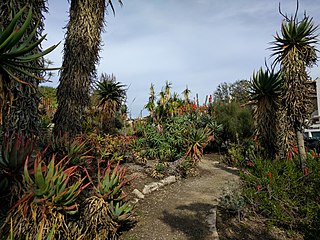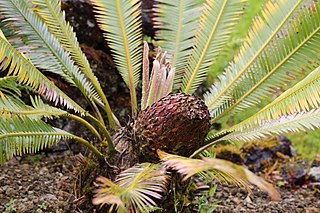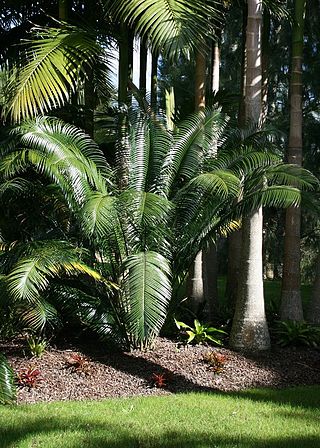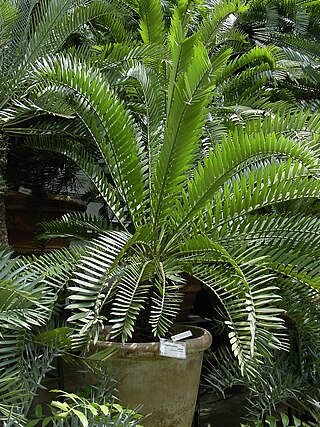The Huntington Library, Art Museum and Botanical Gardens, known as The Huntington, is a collections-based educational and research institution established by Henry E. Huntington and Arabella Huntington in San Marino, California. In addition to the library, the institution houses an extensive art collection with a focus on 18th and 19th century European art and 17th to mid-20th century American art. The property also has approximately 120 acres (49 ha) of specialized botanical landscaped gardens, including the "Japanese Garden", the "Desert Garden", and the "Chinese Garden".

The United States Botanic Garden (USBG) is a botanical garden on the grounds of the United States Capitol in Washington, D.C., near the James A. Garfield Monument.

The Mathias Botanical Garden is a 7-acre (2.8 ha) botanical garden with over 3,000 species of plants, located on the southeastern corner of the University of California, Los Angeles (UCLA) campus. It is named after Mildred Esther Mathias Hassler (1906–1995), a noted American botanist. The director is Victoria Sork. It is also the only free public botanical garden in the Greater Los Angeles area.

Fairchild Tropical Botanic Garden is an 83-acre (34 ha) botanic garden with extensive collections of rare tropical plants including palms, cycads, flowering trees, and vines. It is located in the city of Coral Gables, Miami-Dade County, just south of Miami, surrounded at the north and west by Matheson Hammock Park.

Dioon edule, the chestnut dioon, is a cycad native to Mexico, also known as palma de la virgen. Cycads are among the oldest seed plants and even pre-date the dinosaurs. It belongs to the Zamiaceae plant family within the order Cycadales. The genus name "Dioon" means "two-egged", referring to the two ovules.

Lepidozamia is a genus of two species of cycad, both endemic to Australia. They are native to rainforest climates in eastern Queensland and eastern New South Wales. They have a diploid chromosome number of 2n = 18.

Plant collecting is the acquisition of plant specimens for the purposes of research, cultivation, or as a hobby. Plant specimens may be kept alive, but are more commonly dried and pressed to preserve the quality of the specimen. Plant collecting is an ancient practice with records of a Chinese botanist collecting roses over 5000 years ago.

Encephalartos woodii, Wood's cycad, is a rare cycad in the genus Encephalartos, and is endemic to the oNgoye Forest of KwaZulu-Natal, South Africa. It is one of the rarest plants in the world, being extinct in the wild with all specimens being clones of the type. The specific and common name both honour John Medley Wood, curator of the Durban Botanic Garden and director of the Natal Government Herbarium of South Africa, who discovered the plant in 1895.

The Montgomery Botanical Center, originally known as the Montgomery Foundation, is a nonprofit botanical garden and institution located at 11901 Old Cutler Road, Coral Gables, Florida. It collects seeds from wild plant populations worldwide, with an emphasis on palms and cycads. The garden is a scientific research facility, and not generally open to the public.

The Desert Garden Conservatory is a large botanical greenhouse and part of the Huntington Library, Art Collections and Botanical Gardens, in San Marino, California. It was constructed in 1985. The Desert Garden Conservatory is adjacent to the 10-acre (40,000 m2) Huntington Desert Garden itself. The garden houses one of the most important collections of cacti and other succulent plants in the world, including a large number of rare and endangered species. The 3,000-square-foot (280 m2) Desert Garden Conservatory serves The Huntington and public communities as a conservation facility, research resource and genetic diversity preserve. John N. Trager is the Desert Collection curator.

The Durban Botanic Gardens is situated in the city of Durban, KwaZulu-Natal, South Africa. It is Durban's oldest public institution and Africa's oldest surviving botanical gardens. The gardens cover an area of 15 hectares in a subtropical climate.

Alwyn Howard Gentry was an American botanist and plant collector, who made major contributions to the understanding of the vegetation of tropical forests.

Encephalartos caffer, commonly known as the Eastern Cape dwarf cycad, is a species of cycad in the genus Encephalartos. It is a near threatened species native to South Africa.

The Manie van der Schijff Botanical Garden was formally established in 1934 and is managed by the University of Pretoria. Although the garden was originally established to support research and the conservation of indigenous plants, the garden is open to the public.

Cycas panzhihuaensis is a rare and vulnerable species of cycad known in the wild only from Sichuan and Yunnan provinces in China. It can be seen at the South China Botanical Garden in Guangzhou and is also cultivated for horticulture, where it is often known as the Dukou sago palm.

Encephalartos whitelockii is a species of cycad that is native to Uganda.

Encephalartos hildebrandtii is a species of cycad in the Zamiaceae family. It is native to Kenya and Tanzania at elevations from sea level to 600 metres (2,000 ft). The species is named for the German explorer Johann Maria Hildebrandt.

Cycas seemannii is a species of cycad found in Fiji, Vanuatu, Tonga, and New Caledonia.
Cycas tanqingii is a species of cycad in China and Vietnam. It is found in Luchun County, southern Yunnan Province, China, and in Lai Châu Province, Vietnam. In China, it is located in the Xiaoheidiang River and Heishui River watersheds. In Luchun County, it is protected in Huanglian Mountain National Nature Reserve. It is also cultivated at the Shenzhen Fairy Lake Botanical Garden and at the Forestry Bureau of Luchun County.
Wendell S. Minnich, better known as "Woody" Minnich, is an American field explorer, photographer, grower, and lecturer primarily known for his extensive field documentation of cacti and succulents.
















